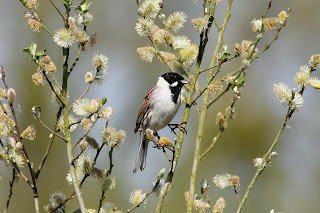If there is one bird that is programmed to sing even when it doesn't want to its the Sedge Warbler. It just can't help itself. A few years ago (rather a few more than I care to imagine) before the Fishlake Meadows estate was built, and when the meadows were pumped out, the reed beds were basically confined to around the pumping station and along the fringes of the ditches, and as such, it was much easier to view the reedbed warbler population. During spring migration you could almost pick up Sedge Warblers from the bushes they were so confiding and obvious and it was hard to hear anything else over their cacophany. I am not complaining, the now largely flooded meadows have produced a quite large reedbed much of which is not accessible and that is generally a good thing for the wildlife inhabitants. Actually, I am complaining in that the houses should have been built with House Martins and Swallows in mind and a bit more scrub should have been left between the dwellings. Still I suppose scrub is hardly a thing you want between (un)affordable housing. Anyway I am probably a dinosaur.
Happily, recently, despite the relative lack so far of Reed Warblers, there has been a large fall of Sedge Warblers, so large in fact that it is often quite difficult to hear anything else that might be secreting itself in the reeds. I have found it quite difficult to observe these noisy, rather harsh little warblers in the last couple of years as they largely sing from the bottom to middle of the reedbeds and rarely pop up unless song flighting. This year however small sapling willows that are sprouting everywhere are providing ideal higher song posts and its just a matter of finding a singing individual in the reedbed and waiting patiently for it to move upwards.
So I did.
This one seemed almost reluctant to perform but just couldn't help itself once I was relatively under cover and stopped singing (and listening occasionally) only to eat a surprise bug that came its way
before carrying on singing almost embarrassed by its interruption
There were lots to choose from given a little patience of which I include just a couple of others
From a distance I thought I had some strange new species here until I realised it was just the shadow of the leaves...
During all this Sedge activity I was delighted to find three pairs of Reed Bunting nesting in a relatively small patch. I only got a few not very good photos of females so I am only going to include one rather indignant male.
During my brief sojurn I can also report that there were two male Cuckoos, umpteen Mallards, plenty of breeding Gadwall (some with chicks), Kestrel, Buzzard, one singing Reed Warbler, two male Pochard, nine singing Cettis (possibly up to eleven), more than ten Blackcaps, a few Chiffchaff, at least a dozen Whitethroats, two Canada Geese, at least one pair of Greylag, several Grey Heron, Coot and Moorhen, a hundred or more Herring Gull, all the rest of the normal Tits, Wrens, Blackbirds, Robins etc, quite a few rats, no Water Vole again, but two Roe Deer.
The Greylags were very flighty although not exactly shy as this close fly by shows.
I apologise to any species I missed out, it was either because I considered you sensitive or just down to plain forgetfulness.








No comments:
Post a Comment